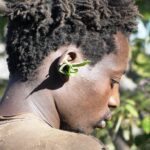Hikes through natural areas in Southern Africa where dangerous game is present must be conducted with at least one, but usually two, armed trail guides. One is the “Lead Guide” or “1st Rifle,” and the second is called the “Back-up Guide” or “2nd Rifle.” Extensive training and exams are required for both qualifications, which the author underwent as a Backup Guide.
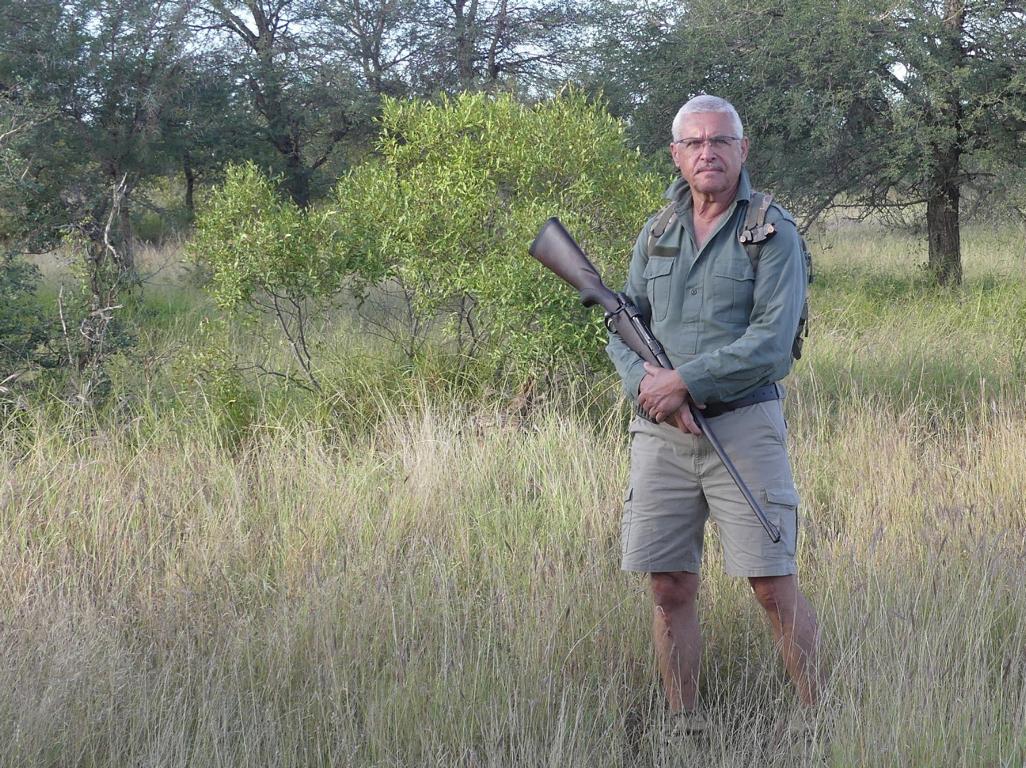
Advanced Rifle Handling examination
One of these exams is called “Advanced Rifle Handling (ARH).” Prerequisites for taking this exam include three preliminary exams covering firearms law, handling of bolt-action rifles, and handling of bolt-action rifles for business purposes.
Upon passing the ARH exam, the necessary rifles may be carried. All trail guides in areas with dangerous game must repeat this exam every three years (New 2024 FGASA ARH protocol). It is described as practical-oriented but challenging, as tiny targets must be hit under time pressure. This skill can only be achieved by automating motor tasks through constant repetition, thus building muscle memory.
As a guide, one should bring clients very close to dangerous game but must prevent critical situations and, therefore, must know the behavior of these species very well. I have attempted to describe the behavior of dangerous African game on my website. See the links further down below.
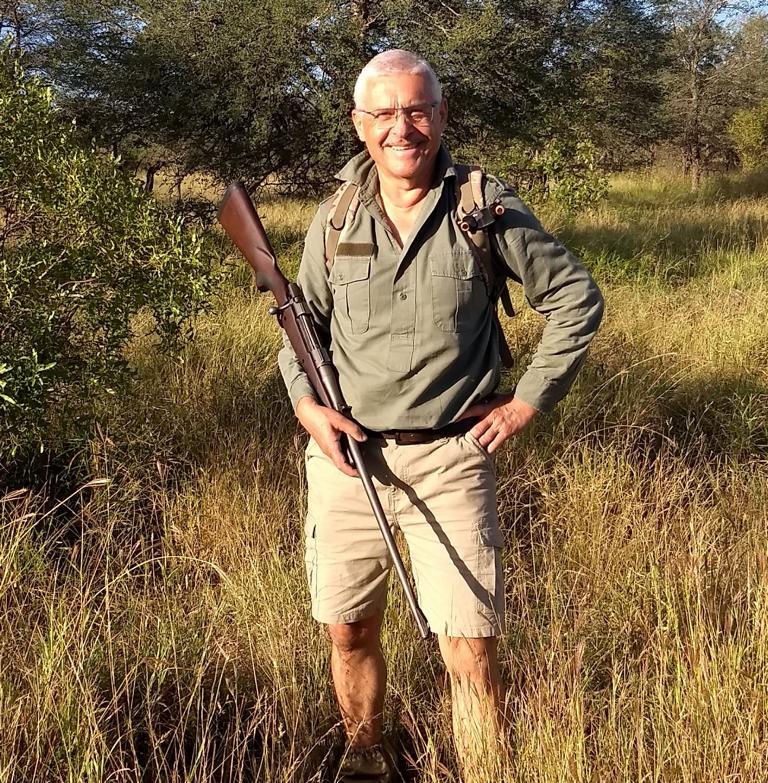
Attacks must not be provoked by the thought that one has a rifle for insurance. Such behavior would lead to exclusion from FGASA (Field Guide Association of Southern Africa) and, thus, a professional ban.
However, if an attack cannot be prevented, the motto is “One shot – One brain.” Once a shot has been fired, it must continue until the attacking animal dies. It may only be fired upon within 10 meters. Outside of this distance, the animal may have swerved off. These situations must be reported immediately to the relevant game warden and the police, and a court hearing will be held without exception.
Statistics show that mainly elephants need to be shot as a last resort. African buffaloes follow as the second. Moreover, the average number of shots fired by Lead and Back-up Guides together per emergency case is statistically 15 shots!
What is considered a Dangerous Game?
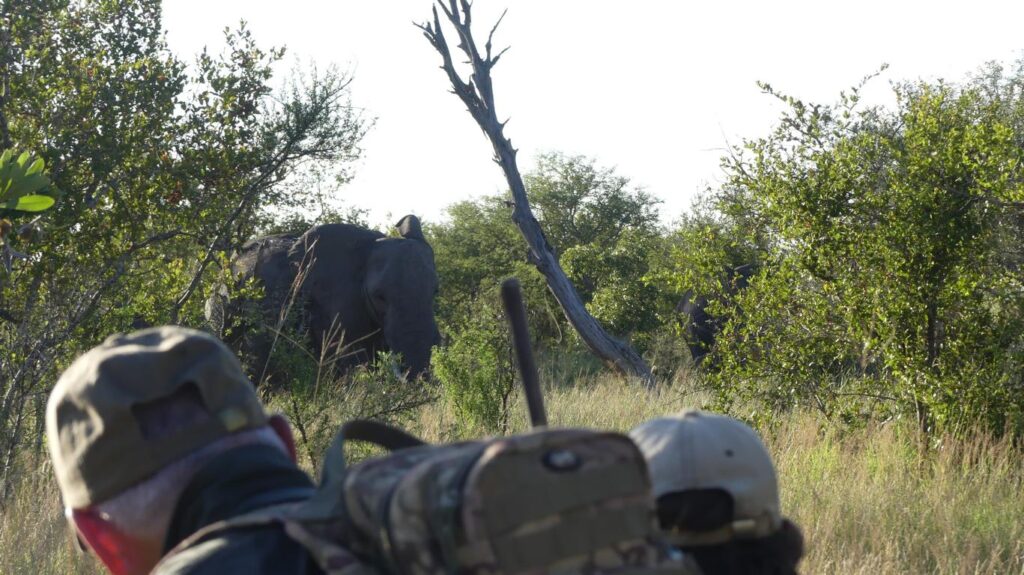
These are the “Big Five” and three other species. In total, eight species in Southern Africa are considered dangerous game. I wrote specific articles explaining the behavior of most of them. These animals are:
- African Savanna Elephant (Loxodonta africana)
- Black Rhinoceros (Diceros bicornis)
- African Buffalo (Syncerus caffer)
- African Lion (Panthera leo)
- Leopard (Panthera pardus)
As well as:
- Spotted Hyena (Crocuta crocuta)
- Nile Crocodile (Crocodylus niloticus)
- Hippopotamus (Hippopotamus amphibius) on land
It should be noted that White Rhinoceros (Ceratotherium simum) were added to the “Big Five” purely for marketing reasons. Many customers want to see the Big Five, and White Rhinoceroses are present in much higher numbers than Black Rhinoceroses. Therefore, “Rhinoceroses” can be presented to customers, and they can then tick them off their bucket list.
Weapons Used for Advanced Rifle Handling and Guiding
Rifles
The life of a guide depends on the rifle’s reliable function, the ammunition used, target selection, accuracy, and nerve strength.
Therefore, simple bolt-action rifles with fixed sights—zeroed at 15 m—are standard weapons. The magazines usually hold four cartridges. All safety elements are often removed, and no rifle sling is generally used. The bluing is replaced by a different surface treatment, such as phosphating, to simplify the maintenance of the steel parts.
The most commonly used rifle model in Southern Africa is the CZ500 by Česká Zbrojovka, based on a Mauser 98 bolt-action system. The Brno Mod. 602 is also popular.
Loading stages
In Southern Africa, the following three loading stages are important:
- Stage 1: The magazine and chamber are empty. The bolt is closed, and the firing pin is uncocked.
- Stage 2: The magazine is loaded, and the chamber is empty. The bolt is closed, and the firing pin is uncocked.
- Stage 4 (Stage 3 = Safety on): A cartridge is loaded in the chamber. Bolt is closed, and the firing pin is cocked. Since, in practice, all rifle safeties have often been removed, this is equivalent to the condition where the safety has been turned off. The rifle is thus ready to fire.
Ammunition
The bullet must be constructed as a monolithic solid bullet to ensure sufficient penetration through thick skin and bones. Soft-point bullets are recommended only for lions and leopards. Therefore, three cartridges with solids are usually loaded, followed by the fourth cartridge with a soft-point bullet. However, this strongly depends on local conditions. The bullet must have a minimum impact energy of 4400 ft-lbs. / 6000 Joules. It would be better to have an impact energy of over 5000 ft-lbs. / 6800 J.
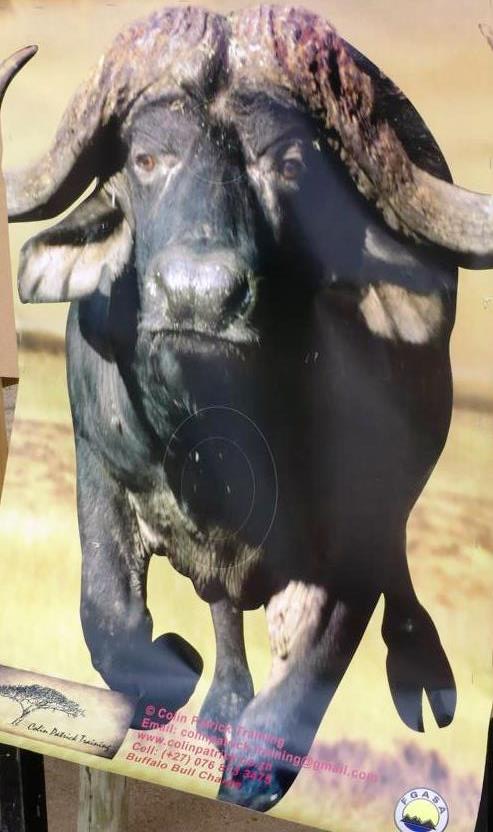
The following calibers suit this: .375 Magnum caliber, .416 (Rigby et al.), and especially .458 Winchester Magnum. In between, there are several other suitable custom calibers.
We completed the Advanced Rifle Handling exam with a .458 WinMag, a standard load, a monolithic bullet of 475 grains / 31 grams, and a v0 of 2100 ft/s / 640 m/s.
Before each shooting exercise or hike with clients, each of the ten cartridges, carried on the cartridge belt according to regulations, must be loaded and unloaded (“cycled”). Since large-caliber cartridges are not always commercially available in Southern Africa, they are often hand-loaded. This does not always ensure the bullet holds firmly, and the chamber can be jammed. This problem occurs relatively usually. This loading test is, therefore, a must before each possible use.
Safety at the Shooting Range
Before shooting, a safety briefing is conducted, and the most important rules of conduct are reiterated. If someone points the rifle toward people or if the trigger finger is not always extended beside the trigger guard (except when firing), one must immediately leave the shooting range. This also applies to an unintentional shot fired or if animals appear in the direction of fire and you still shoot. This happened to a colleague when suddenly two giraffes appeared in the background. The exam may be repeated no earlier than one day later. Safety rules are generally enforced much more strictly than in other countries.
The procedure of the Advanced Rifle Handling Shooting Test
There are precise regulations for the procedures for each of the following exercises. For better readability, this article presents only the essential requirements. Distances to the targets are very short in practice, and there is usually intense time pressure. If a cartridge falls to the ground after the command “Prepare yourself” is given, this leads to disqualification from the exam.
Exercise No. 1 – Blindfold quick loading.
The rifle is unloaded (Stage 1) with ten shots on the belt. One must carry a backpack, and the eyes are covered with a blindfold. Upon command, a cartridge must be pulled from the belt and loaded individually. Then, one must aim, keep a finger on the trigger without firing, eject the cartridge, rest the rifle in the loin, and load a new cartridge. The three cartridges’ entire loading and aiming cycle must be done smoothly within 12 seconds.
This first exercise is challenging because .458 WinMag cartridges are long and thick, and the magazine lip wobbles back and forth. With a lot of practice and sensitivity, one must quickly balance the position of the cartridge so that the bolt can chamber it smoothly. The 12 seconds cannot be achieved if there is a jam. Moreover, if a cartridge falls to the ground, one is immediately disqualified from Advanced Rifle Handling.
Exercise No. 2 – Accuracy
The rifle is half-loaded with four cartridges and held in the left hand at the start of shooting. Upon command, five shots are fired at a target at a distance of 12 meters without time pressure. All five shots must land within the FGASA target (approximately 15 cm in diameter). This is a relatively straightforward exercise. However, some beginners may struggle to consistently place all five shots within the circle due to nervousness.
Exercise No. 3 – Distance
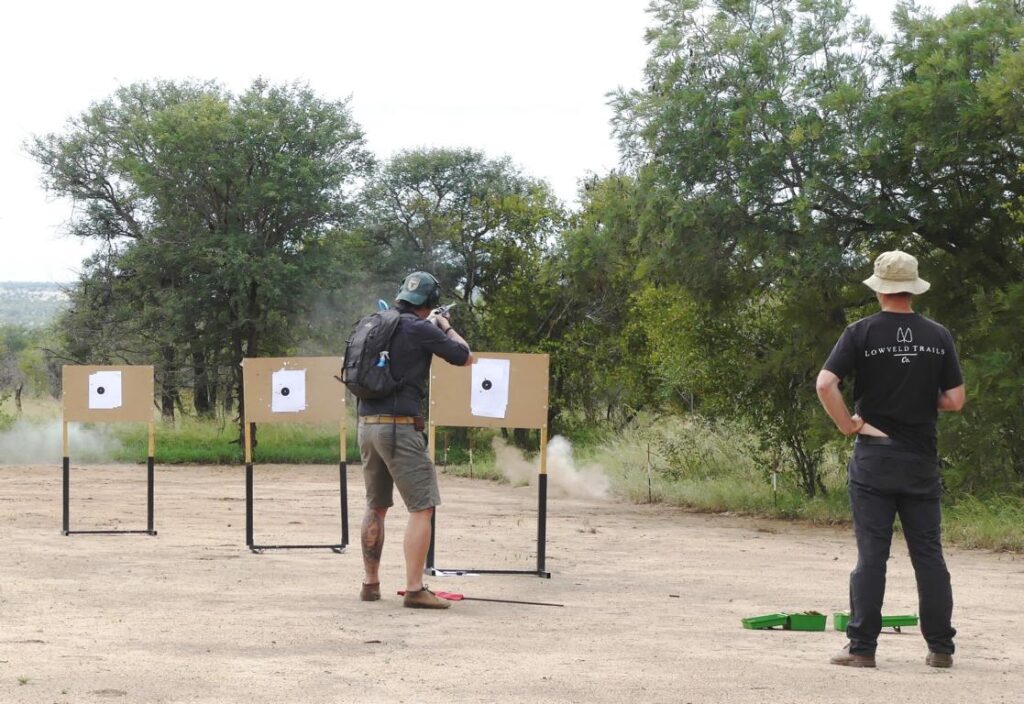
The rifle is again half-loaded with four cartridges (Stage 2). Upon command, one shot each is fired at distances of 12m, 8m, and 4m, then a new cartridge is chambered and aimed at the 4m target again – but not fired. Total points are awarded for a time under 10 seconds for the exercise from the command to picking up the target with the fourth cartridge. Above 14 seconds, one is disqualified as NYC (Not Yet Competent). Similarly, one is disqualified if the three shots do not land within the target circle, if the index finger is not placed horizontally next to the trigger guard for the fourth cartridge, or if safety violations occur during unloading.
Exercise No. 4 – Immediate Action after the misfire of a cartridge
Ten cartridges are provided, nine of which are live rounds, and one is a dummy (no ignition or charge). The shooting supervisor loads three cartridges into the magazine, including the dummy cartridge. This can be the first, second, or third without the candidate knowing. The half-loaded rifle is then handed to the examinee.
Upon command, three shots are fired at the target 8 meters away. However, one of the three shots will not ignite. Then (as a right-handed shooter), the rifle must be rotated 90 degrees to the left, and the cartridge must be extracted. It must then come to rest within a radius of 1m next to the examinee’s legs. After that, the magazine must be reloaded to fill the total capacity, and the three test shots must be completed. Then, another cartridge must be chambered, and the target must be aimed at but not fired. Timekeeping ends at this point. Total points are awarded for a time of 22 seconds. Above 26 seconds, one is declared “Not Yet Competent”. All three shots must land within the FGASA target circle.
Exercise No. 5 – Shot placement.
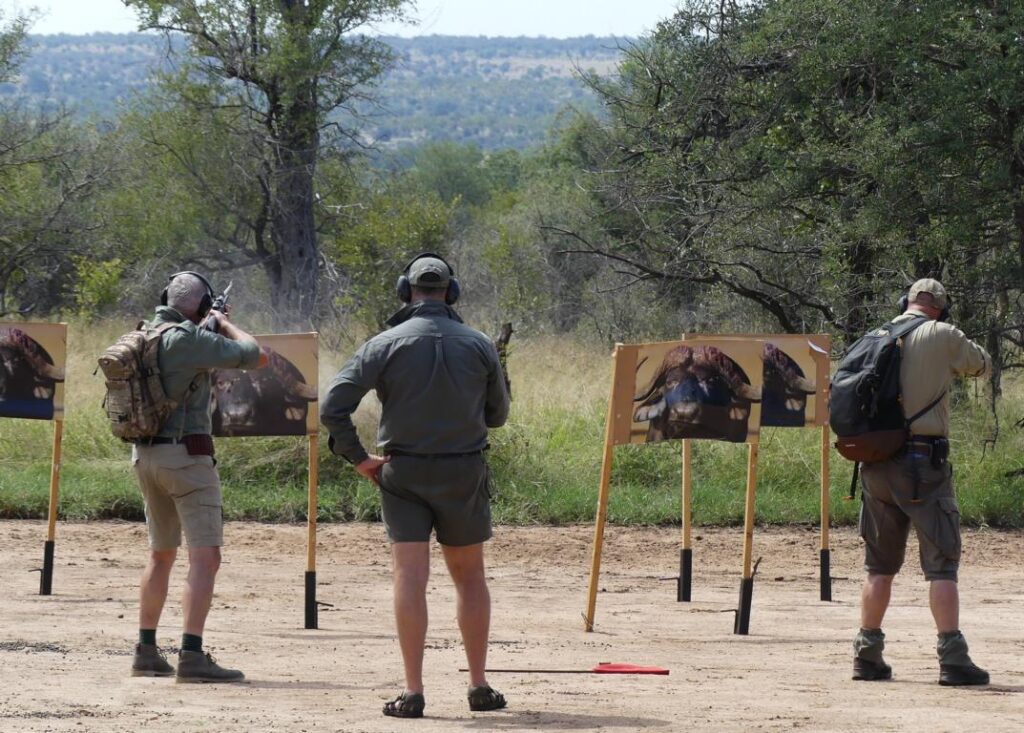
In this exercise, two FGASA buffalo targets are used. The target circles on the targets are only visible from a very close range. Therefore, when shooting, one must have a clear idea of the location of the brain. Two shooters stand side by side at a distance of about 4 meters and must, upon command, simultaneously shoot one target at 8m and then one at 4m. Then, another cartridge must be chambered and aimed at the 4m target again. Timekeeping ends at this point. Total points are awarded for under 8 seconds, and over 12 seconds results in being declared not competent. Both shots must land within the brain circle on the targets.
Exercise No. 6 – Simulated charge.
This is a challenging exercise because the first shot must be fired quickly and accurately, and the procedures after the first shot must also be precisely followed.
The target device is a carriage with a life-sized FGASA lion target. This carriage is connected to a winch with a steel cable, which pulls the carriage at a speed of 8 m/s. The distance between the target and the winch is 30 meters. When the winch is activated, it takes about 4 seconds for the carriage to reach the endpoint, and shooting at the target is only allowed from the 10-meter point inwards.
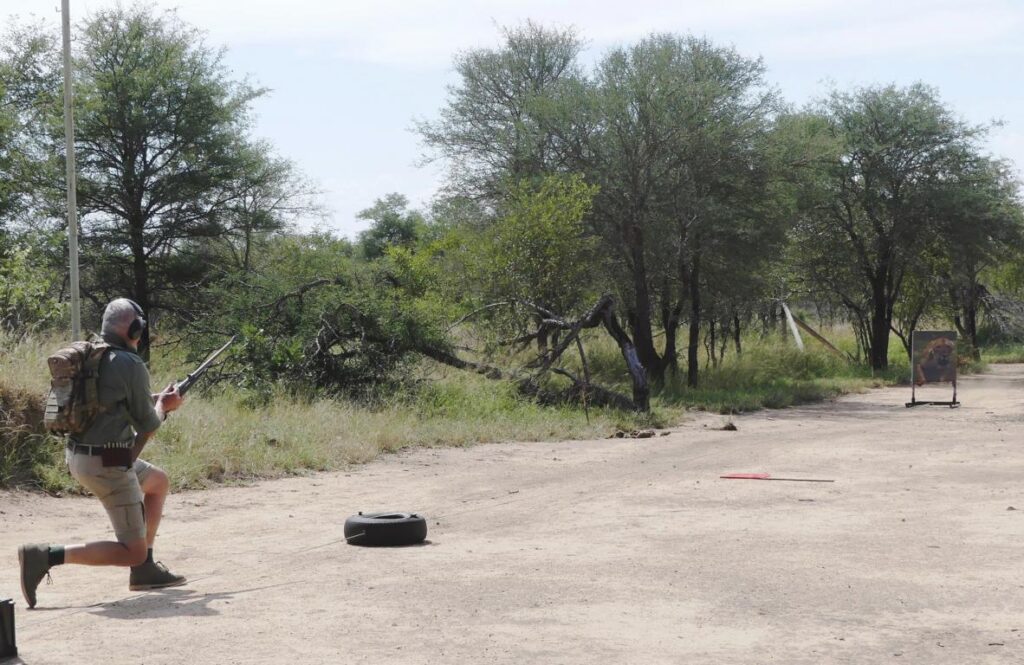
With the half-loaded rifle containing one live round and three dummies and carrying ten dummy rounds on the belt, the candidate walks from the staging area to the left side of the winch with the rifle in the left hand. Once level with the winch, it is activated, and the target carriage rushes towards the shooter.
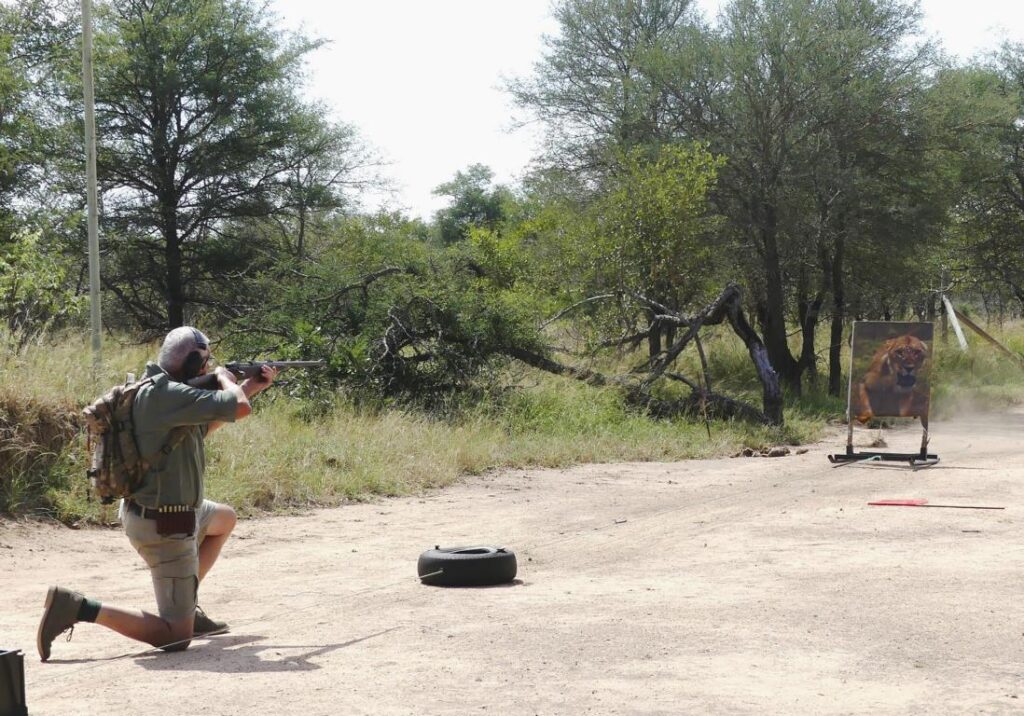
The candidate must then kneel (aiming at the same height as the target increases the likelihood of hitting), load, and shout, “Lion, stand still.” In an actual situation, one would shout, “Elli, stand still,” or “Buff, stand still,” depending on the attacking animal species. This call is essential for legal reasons in a possible court hearing.
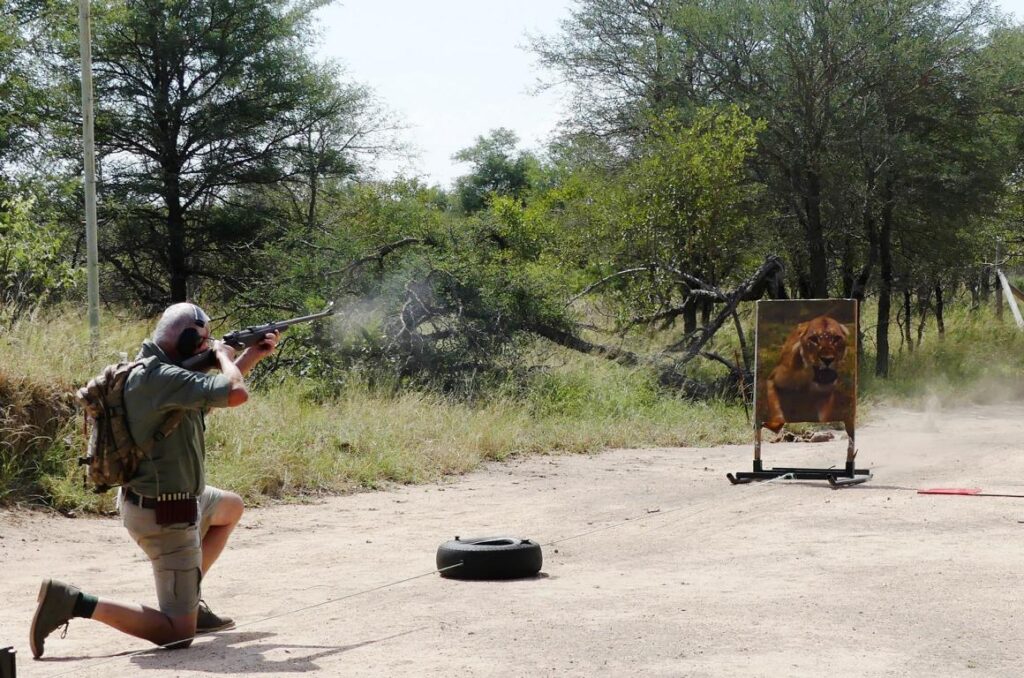
After that, the target is acquired and fired upon within the 10-meter zone. After the first shot, a second shot is immediately fired as an insurance shot.
Procedure after the first two shots
Then, one must turn around and loudly instruct the clients to retreat.
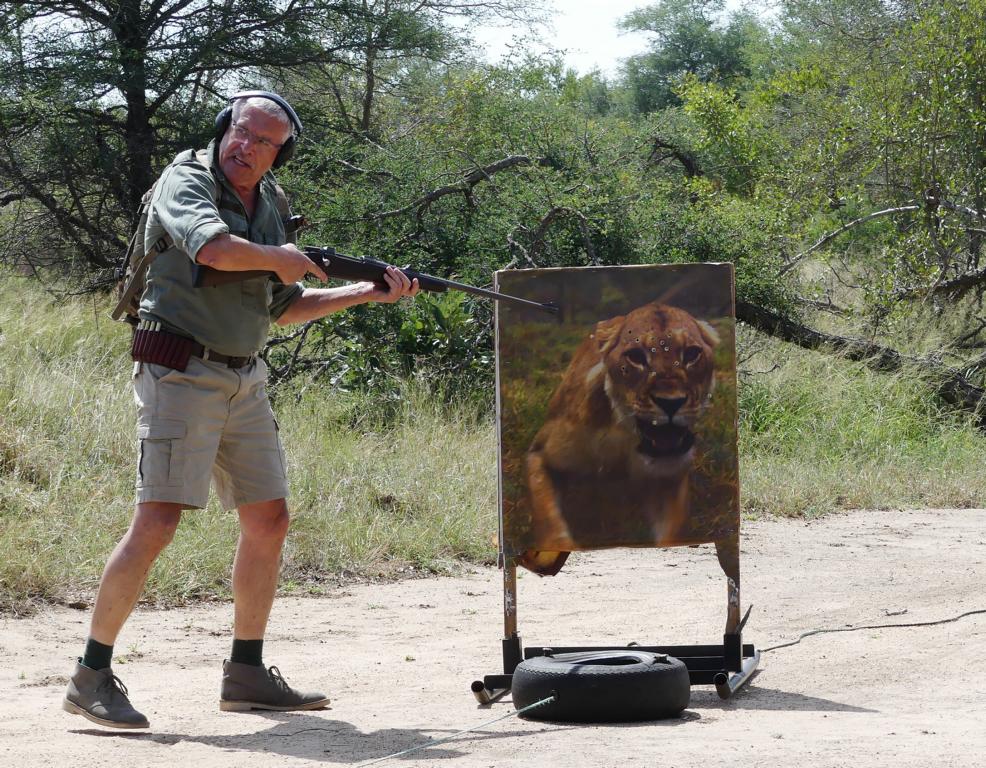
After this instruction, the coup de grâce is delivered. This involves chambering another round, aiming at the brain again, and firing.
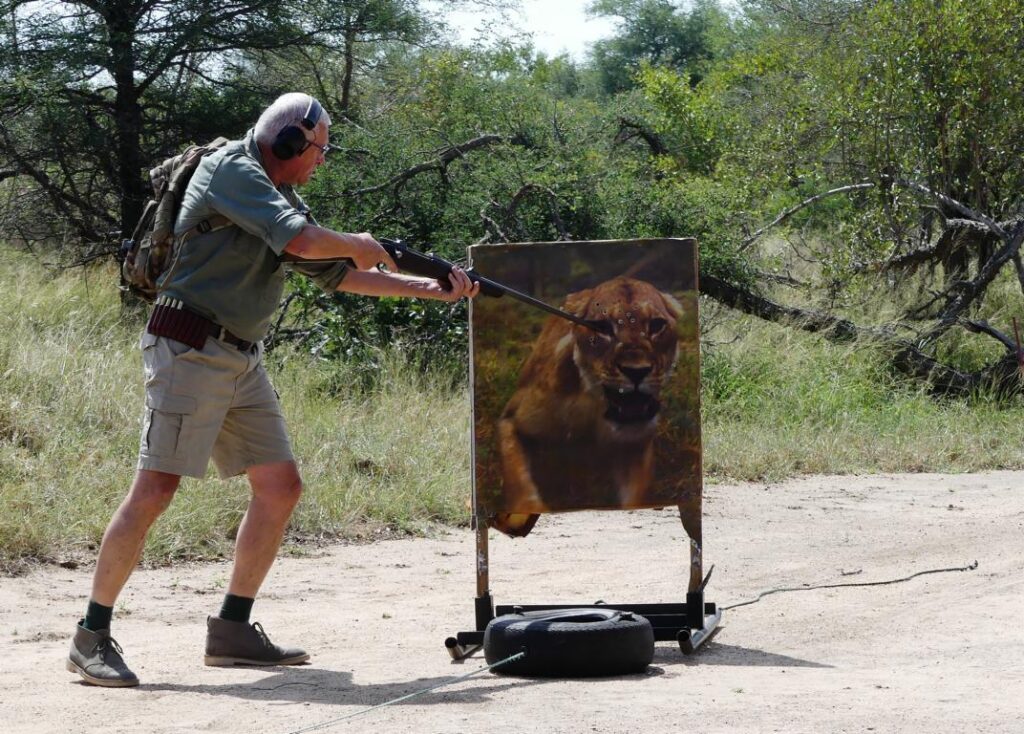
Next, the corneal reflex of the eye is tested. The rifle is taken in the extended hand, and the muzzle is pressed against the animal’s eye. If a reflex occurs, shots are fired at the brain until the animal is dead, and no reflex occurs. Then, one steps back a few meters, puts the rifle in Stage 2, and attends to the clients.
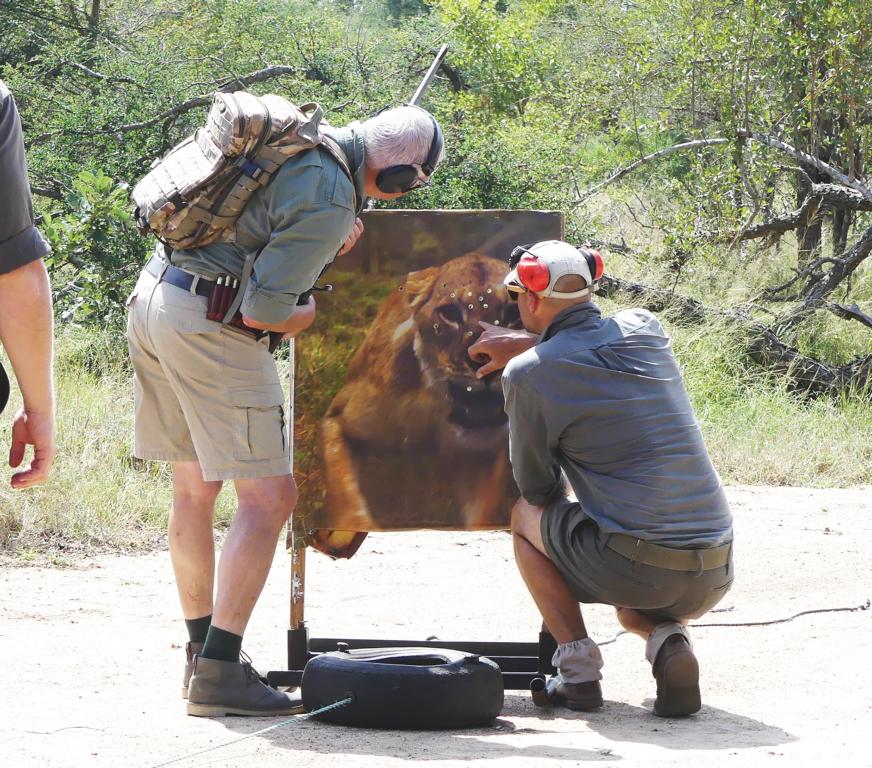
Of course, no clients are present during the exam, but everyone is pleased to see if the first shot hits the lion’s brain with a maximum size of 7 cm. This test is one of the foundations for guiding clients on foot in savannas and allowing them to experience the beauty of Africa up close.
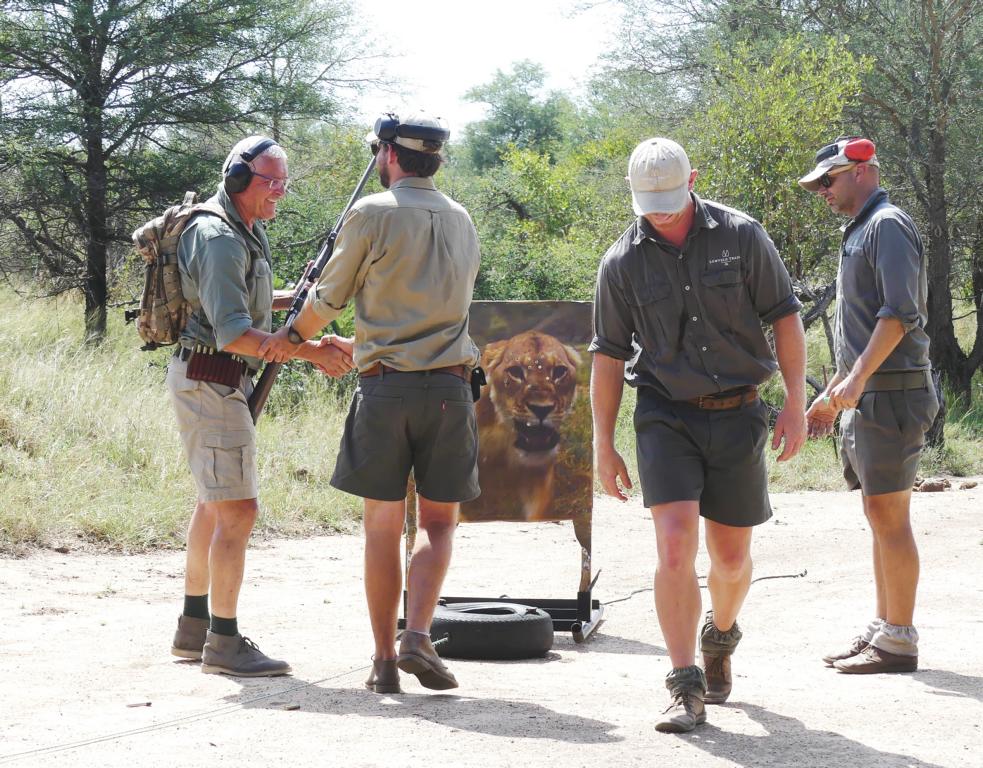
Words of Thanks
I sincerely thank Mr. Leighton A. Barnard of the Lowveld Trails Co. in Hoedspruit, South Africa, for his professional mentoring in shooting and preparing our group for the Advanced Rifle Handling examination. Building up muscle memory so quickly would not have been possible without him. Thank You, Leighton!



